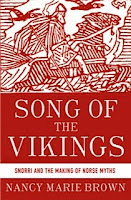I pointed you, my readers, to the 360-degree interactive video from the British Museum in which you can turn the chess queen all the way around as if holding her in your hand. (See it again here)
The caption calls her expression sad or gloomy. When I used a photograph of a different one of the eight Lewis queens as an illustration in my earlier book, Song of the Vikings, I called her expression "aghast."
So I asked you to tell me, "What is the queen thinking?" Your answers were very creative--and some of them were very helpful--but they were also widely varied.
You described her as concerned, surprised, taken aback, wretched, perplexed, pensive—or perhaps suffering a toothache. "Do I really have fifteen kids who fight all the time?" said one of you; another described her state-of-mind as "weary of war and fools."
Icelandic author Fridrik Erlingsson responded most fully: "I think the expression on the Queen's face is an intimidating one; an expression of cold calculation, focus and determination: She is planning the next move!"
Actors in classical Roman theater, I learned, held a hand to the cheek to express grief, and Anglo-Saxon artists picked up on this gesture. In eleventh-century manuscripts from Canterbury, Adam and Eve cast out from Eden, a psalmist whose "spirit has failed," and a female personification of Unrighteousness all lament their fates with their hands on their cheeks. Yet there's a subtle difference between these images and the Lewis queens: In the Canterbury manuscripts, the hands are cupped and the fingers spread almost like claws. They hide the eye, sometimes even the nose and mouth. And rather than glaring at the observer, as the Lewis queens do, these grievers are hunched and cowed.
A twelfth-century life of Saint Alexis, made for the hermitess Christina of Markyate, depicts the saint's virgin bride standing stoically at the door, a hand to her cheek, as Alexis abandons her to become a holy beggar. Following Christian law, she would not be able to remarry while he lived. (See it here) Still, her grief is hardly commensurate with that of the Virgin Mary who, in some twelfth-century Crucifixion scenes, likewise holds her hand to her cheek.
Comparing these contemporaneous images to the Lewis queens, James Robinson in a 2004 British Museum booklet explained that "There is an element of despair or grieving, but the emotional focus is really on contemplation." According to Neil Stratford in an earlier museum publication, "the queens adopt the traditional pose of composure and patience."
 In a children’s book by British Museum curator Irving Finkel, they are "careworn and anxious," "disapproving," "imperious," and "not amused." Author Rosemary Sutcliff, in her children's book Chess-Dream in a Garden, imagines the queen feeling hurt and angry, having been accused, unfairly, of smiling "too sweetly" on one of the knights. A columnist for The Guardian found them "looking so wise (or so bored)." A New York Times reporter compared the gesture to Homer Simpson's "D'oh!"
In a children’s book by British Museum curator Irving Finkel, they are "careworn and anxious," "disapproving," "imperious," and "not amused." Author Rosemary Sutcliff, in her children's book Chess-Dream in a Garden, imagines the queen feeling hurt and angry, having been accused, unfairly, of smiling "too sweetly" on one of the knights. A columnist for The Guardian found them "looking so wise (or so bored)." A New York Times reporter compared the gesture to Homer Simpson's "D'oh!" Often your interpretation depends on which of the eight queens you look at--and how you turn her to the light. To poet Robert Peake, "She is worry cut from walrus tusk / … One hand on her face in disbelief." (Read more at www.robertpeake.com.) To singer Dougie MacLean, "She holds her weary head."
Francesca Simon visited the British Museum's collection to publicize her book, The Sleeping Army, in which the Lewis chessmen wake to take a little girl on an adventure. In a 2011 video (see it on YouTube here), she said, "What I wasn't expecting was that they would seem so alive. ... The more you look at them the more you see, like the fact that the queen is always looking a little bit to the side. It's very difficult to get her to look at you. ... She's probably the most beautiful of all the pieces. She's got this wonderful expressive face and these kind of odd staring eyes, and to me what they always looked like was not only unhappy but almost shell-shocked, as if something pretty terrible has happened."
I think I'll stick with "aghast."
Read more about Ivory Vikings on my website, http://nancymariebrown.com, or meet me at these upcoming events:
October 13, 2015: Fletcher Memorial Library, 88 Main Street, Ludlow, VT, at 7 pm. Sponsored by The Book Nook, Ludlow, VT.
October 15, 2015: Kroch Library 2B48, home of the Fiske Icelandic Collection at Cornell University, Ithaca, NY, at 4:30 pm. See Book Talk: Ivory Vikings for more details.
October 17, 2015: the Sixth Annual Iceland Affair, Winchester Center Grange Hall, Winchester Center, CT, at noon. See http://icelandaffair.com for more details.















